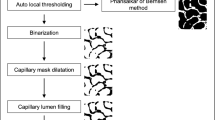Abstract
The present study aimed to examine the changes induced in proximal tubules by renal congestion using the in vivo cryotechnique (IVCT). Twelve male Wistar rats were divided into four equal groups: group 1 (the control); groups 2 and 3, which were subjected to 2 and 5 min of congestion, respectively; and group 4, which was subjected to 5 min of congestion followed by 10 min of recirculation. Under anesthesia, renal congestion was induced in the bilateral kidneys by ligating the inferior vena cava just above the branching renal veins. The left kidneys, which were subjected to the IVCT, were then compared with the right kidneys, which underwent a conventional fixation method. Among the left kidneys, the proximal tubules in group 1 consisted of cuboidal cells and had open lumina. In the congestive groups, the diameters of the proximal tubules were increased, and their lumina were obstructed by swollen cells and ischemia-associated cell debris. In group 4, the proximal tubules were still dilated, as seen in the congestive groups; however, the swollen cells had recovered their cuboidal form, and the cell debris had disappeared from the tubules’ lumina. The present study demonstrated the in vivo morphology of proximal tubules in living rats subjected to congestion, which was unclear using conventional fixation methods.







Similar content being viewed by others
References
Hayat MA (1989) Chemical fixation. In: Hayat MA (ed)Principles and techniques of electron microscopy, 3rd edn. Macmillan press, Houndmills, pp 1–78
Ohno S, Terada N, Fujii Y, Ueda H, Takayama I (1996) Dynamic structure of glomerular capillary loop as revealed by an in vivo cryotechnique. Virchows Arch 427(5):519–527
Yu Y, Leng CG, Terada N, Ohno S (1998) Scanning electron microscopic study of the renal glomerulus by an in vivo cryotechnique combined with freeze-substitution. J Anat 192(Pt 4):595–603
Ohno S, Kato Y, Xiang T, Terada N, Takayama I, Fujii Y, Baba T (2001) Ultrastructural study of mouse renal glomeruli under various hemodynamic conditions by an “in vivo cryotechnique”. Ital J Anat Embryol 106(2 Suppl 1):431–438
Ohno N, Terada N, Saitoh S, Zhou H, Fujii Y, Ohno S (2007) Recent development of in vivo cryotechnique to cryobiopsy for living animals. Histol Histopathol 22(11):1281–1290
Li Z, Terada N, Ohno N, Ohno S (2005) Immunohistochemical analyses on albumin and immunoglobulin in acute hypertensive mouse kidneys by “in vivo cryotechnique”. Histol Histopathol 20(3):807–816
Zhou D, Ohno N, Terada N, Li Z, Morita H, Inui K, Yoshimura A, Ohno S (2007) Immunohistochemical analyses on serum proteins in nephrons of protein-overload mice by “in vivo cryotechnique”. Histol Histopathol 22(2):137–145
Matsumoto N, Hemmi A, Yamato H, Ohnishi R, Segawa H, Ohno S, Miyamoto K (2010) Immunohistochemical analyses of parathyroid hormone-dependent downregulation of renal type II Na-Pi cotransporters by cryobiopsy. J Med Invest 57(1–2):138–145
Fujii Y, Ohno N, Li Z, Terada N, Baba T, Ohno S (2006) Morphological and histochemical analyses of living mouse livers by new ‘cryobiopsy’ technique. J Electron Microsc (Tokyo) 55(2):113–122
Ohno N, Terada N, Ohno S (2006) Histochemical analyses of living mouse liver under different hemodynamic conditions by “in vivo cryotechnique”. Histochem Cell Biol 126(3):389–398
Takayama I, Terada N, Baba T, Ueda H, Fujii Y, Kato Y, Ohno S (2000) Dynamic ultrastructure of mouse pulmonary alveoli revealed by an in vivo cryotechnique in combination with freeze-substitution. J Anat 197:199–205
Sanders PW (1994) Pathogenesis and treatment of myeloma kidney. J Lab Clin Med 124(4):484–488
Heher EC, Rennke HG, Laubach JP, Richardson PG (2013) Kidney disease and multiple myeloma. Clin J Am Soc Nephrol 8(11):2007–2017
Terada N, Kato Y, Fuji Y, Ueda H, Baba T, Ohno S (1998) Scanning electron microscopic study of flowing erythrocytes in hepatic sinusoids as revealed by ‘in vivo cryotechnique’. J Electron Microsc (Tokyo) 47(1):67–72
Takayama I, Terada N, Baba T, Ueda H, Kato Y, Fujii Y, Ohno S (1999) “In vivo cryotechnique” in combination with replica immunoelectron microscopy for caveolin in smooth muscle cells. Histochem Cell Biol 112(6):443–445
Zea-Aragon Z, Terada N, Ohtsuki K, Ohnishi M, Ohno S (2005) Immunohistochemical localization of phosphatidylcholine in rat mandibular condylar surface and lower joint cavity by cryotechniques. Histol Histopathol 20(2):531–536
Terada N, Ohno N, Li Z, Fujii Y, Baba T, Ohno S (2005) Detection of injected fluorescence-conjugated IgG in living mouse organs using “in vivo cryotechnique” with freeze-substitution. Microsc Res Tech 66(4):173–178
Terada N, Saitoh Y, Saitoh S, Ohno N, Jin T, Ohno S (2010) Visualization of microvascular blood flow in mouse kidney and spleen by quantum dot injection with “in vivo cryotechnique”. Microvasc Res 80(3):491–498
Zea-Aragón Z, Terada N, Ohno N, Fujii Y, Baba T, Ohno S (2004) Effects of anoxia on serum immunoglobulin and albumin leakage through blood–brain barrier in mouse cerebellum as revealed by cryotechniques. J Neurosci Methods 138(1–2):89–95
Saitoh S, Terada N, Ohno N, Ohno S (2008) Distribution of immunoglobulin-producing cells in immunized mouse spleens revealed with “in vivo cryotechnique”. J Immunol Methods 331(1–2):114–126
Ohno N, Terada N, Murata S, Katoh R, Ohno S (2005) Application of cryotechniques with freeze-substitution for the immunohistochemical demonstration of intranuclear pCREB and chromosome territory. J Histochem Cytochem 53:55–62
Acknowledgments
The authors are grateful to Prof. Yoshihiko Ueda (Department of Pathology, Dokkyo Medical University Koshigaya Hospital) for his helpful advice. This study was supported by a Grant for the Strategic Research Base Development Program for Private Universities, which is subsidized by MEXT (2010). A part of this study was reported at the 54th Meeting of the Japanese Society of Histochemistry and Cytochemistry.
Author information
Authors and Affiliations
Corresponding author
Rights and permissions
About this article
Cite this article
Hemmi, S., Matsumoto, N., Jike, T. et al. Proximal tubule morphology in rats with renal congestion: a study involving the in vivo cryotechnique. Med Mol Morphol 48, 92–103 (2015). https://doi.org/10.1007/s00795-014-0084-x
Received:
Accepted:
Published:
Issue Date:
DOI: https://doi.org/10.1007/s00795-014-0084-x



